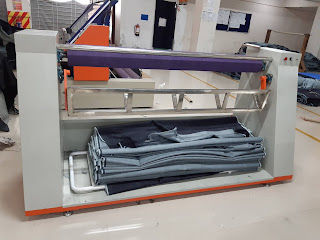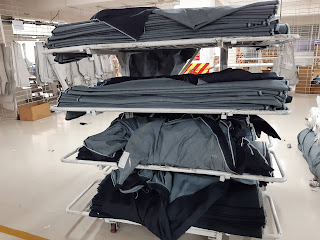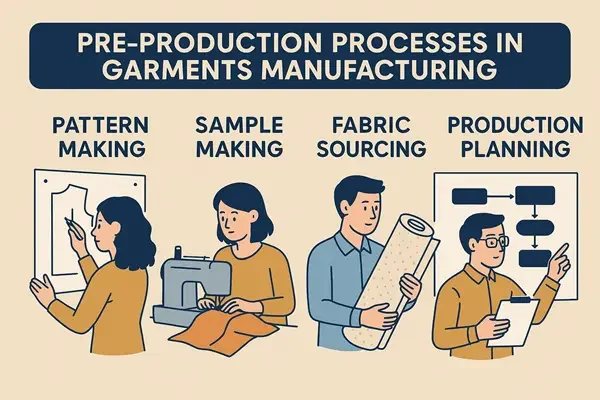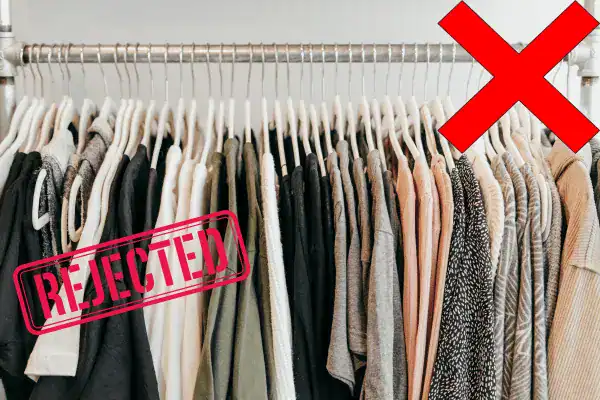Fabrics Relaxation Procedure of Apparel Industry
Fabrics Relaxation Procedure of the Apparel Industry
Fabrics Relaxation
Keeping fabrics in a relaxed mode from opening the tie and cover, has to be done in the cutting room at natural temperature. Fabrics relaxation means relaxing fabrics by unrolling and opening conditions without having tension. In this article, we are discussing the Fabrics Relaxation Procedure of the Apparel Industry.
Relaxation is very important to get the fabric’s own shape, garments measurements depend on proper fabric behavior. Relaxation is necessary for stretch fabrics. The objective of fabric relaxation is to keep the fabric’s dimensional stability after cutting. Fabric relaxation time depends on the fabric’s nature and customer requirements. This article is all about Fabrics relaxation SOP as a detail of the Fabrics Relaxation Procedure of the Apparel Industry.

Fabrics Relaxation steps/ Flow Chart
Received Fabrics from Warehouse
↓
Fabrics Unrolling through Machine/ Manually
↓
Keeping Fabrics in a Relaxation Rack for a certain period (Relaxation time will depend on Fabric’s Nature)
↓
Fabrics spread/ Lay for cutting
↓
Relax Fabrics two-hour
↓
Start Cutting
From Fabrics Relaxation to Cutting
- Fabrics Unrolling through Machine: Opening fabrics from roll form, using a relaxation machine is very handy. Keeping Fabrics in Relaxation Rack in a certain period: Different fabrics have different requirements for fabric relaxation time. Generally, stretch fabrics need to relax for 24-48 hours, and 100% cotton fabrics need less or no relaxation.

- Fabrics spread/ Lay for cutting: After completing relaxation, fabrics lay/ spread on the cutting table.
- Relax Fabrics for two hours: After spreading, there also needs to relaxed fabrics to ensure if spreading is done pulling fabrics too high so that they can be fixed in their own dimension.
- Start Cutting: Now you can cut fabrics as per the procedure.
- Making Fabrics Relaxation Report in Cutting Section: The QC team keeps documents of the Fabrics Relaxation Report. The report should include relaxation starting time, date, fabric nature, and all other necessary data.
How long do we need to relax the fabric before cutting it?
Relaxation time depends on the fiber, structure, and parameters of the Fabrics. Here is a list of data on which fabric needs how many hours of relaxation before cutting. This data is made based on working experience:
| Serial | Fabrics Construction | Fiber Content | Relaxation Time |
| 1 | Twill Fabric | 100% Cotton | 24 Hours |
| 2 | Twill Fabric | Cotton + Spandex | 48 Hours |
| 3 | Denim Twill | Cotton | 24 Hours |
| 4 | Denim Twill | Cotton + Spandex | 48 Hours |
| 5 | Canvas Fabric | 100% Cotton | 12 Hours |
| 6 | Single Jersey | 100 % Cotton | 12 Hours |
| 7 | Single Jersey | CVC/ PC | 10 Hours |
| 8 | Single Jersey | Lycra Mix | 48 Hours |
| 9 | Interlock | 100 % Cotton | 24 Hours |
| 10 | Interlock | CVC/ PC | 12 Hours |
| 11 | Interlock | Lycra Mix | 48 Hours |
| 12 | Pique (S/L) | 100 % Cotton | 24 Hours |
| 13 | Pique (D/L) | CVC/ PC | 24 Hours |
| 14 | Pique (Honeycomb) | Lycra Mix | 48 Hours |
| 15 | Pique | CVC/ PC | 12 Hours |
| 16 | Pique | Lycra Mix | 48 Hours |
| 17 | Fleece | CVC/ PC | 12 Hours |
| 18 | Fleece | Lycra Mix | 48 Hours |
| 19 | Rib (1/1, 2/2) | 100% Cotton | 24 Hours |
| 20 | Rib | Lycra Mix | 48 Hours |
- You may love to read: Automatic Fabric Relaxation SOP in the Garments industry.



